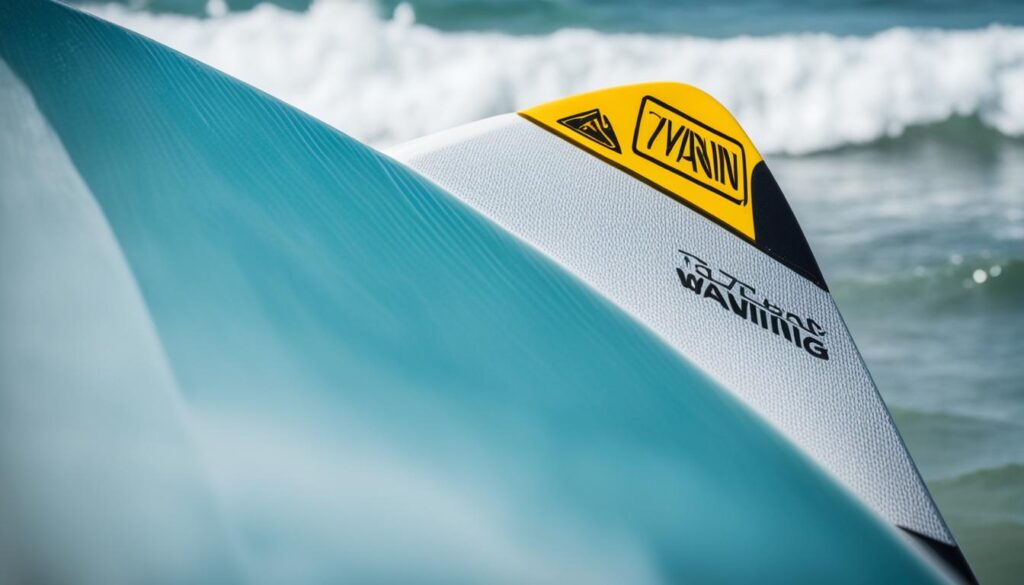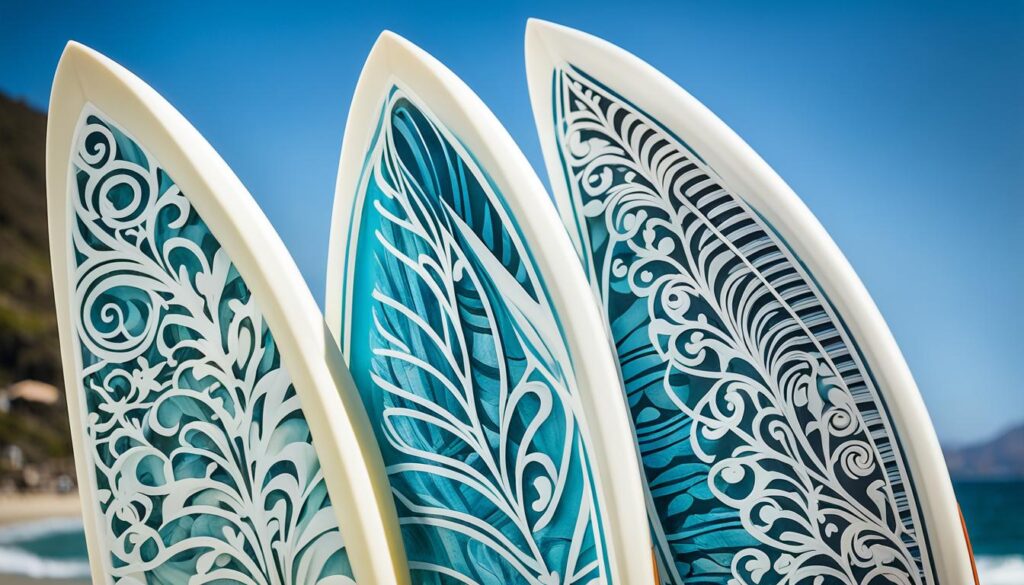When you think of surfing, you might imagine the rush of catching the perfect wave or the thrill of gliding along the water. But have you ever stopped to consider the potential dangers lurking beneath the surface? One commonly overlooked hazard is the surfboard fin. Are surfboard fins sharp? And could they pose a risk to your safety? Let’s dive deep into the world of surfboard fin safety, injuries, and maintenance to find out.
- Surfboard fins can cause serious injuries, accounting for about 55% of surf-related injuries.
- Cuts and scrapes from sharp fins can lead to dangerous infections, including life-threatening staph infections.
- Minimize the risk of cuts by opting for softer fins or sanding down the edges of your fins.
- Wearing booties can also protect your feet from coral cuts.
- By taking these precautions, you can greatly reduce the chances of injuries caused by surfboard fins.
Trauma to the Head, Neck, and Shoulders
One of the potential risks that surfers face in the water is trauma to the head, neck, and shoulders. This type of injury can occur in various ways, such as when surfers accidentally hit themselves with their own boards, collide with other surfers, or come into contact with submerged rocks or the ocean floor.
Beginner surfers are particularly vulnerable to these injuries due to their limited experience and lack of control over their boards. However, there are precautions that can be taken to minimize the risk. Using soft foam boards, for example, can help reduce the impact and severity of injuries in case of accidental contact.
Wearing helmets is another effective measure for protecting the head from potential trauma. Surf helmets are designed to absorb impact and provide cushioning, reducing the risk of head injuries and concussions. They are especially recommended for beginner surfers and those who surf in areas with shallow water or rocky bottoms.
In addition to head injuries, surfers should also be mindful of their neck and shoulder health. Stretching before surfing can help warm up the muscles and increase flexibility, reducing the chances of strains and other injuries to these areas.
It is essential to recognize the signs of more serious injuries and seek medical attention promptly. If there are any symptoms of a concussion or severe pain in the neck, back, face, or jaw, it is important to consult a healthcare professional for a thorough evaluation and appropriate treatment.
Comparison of Soft Foam Boards and Traditional Surfboards
| Aspect | Soft Foam Board | Traditional Surfboard |
|---|---|---|
| Impact Absorption | High | Low |
| Board Weight | Lighter | Heavier |
| Surfing Performance | Beginner-friendly | Enhanced maneuverability |
| Durability | Less prone to damage | Requires regular maintenance |
By taking precautions and staying vigilant while enjoying the waves, surfers can minimize the risk of head, neck, and shoulder injuries and ensure a safer and more enjoyable surfing experience.
Eye Injuries from Surfboard Tips
When it comes to surfing, eye injuries caused by surfboard tips are a serious concern. The sharp edges of the surfboard can cause significant damage if they come into contact with a surfer’s eyes. It is crucial for surfers to take precautions to protect their eyes and prevent potential injuries.
One effective way to minimize the risk of eye injuries from surfboard tips is to use a soft nose guard on the tip of the board. The nose guard acts as a protective barrier, cushioning the impact and reducing the likelihood of direct contact with the eyes. By implementing this simple measure, surfers can significantly decrease the risk of eye injuries.
Additionally, maintaining a safe distance from other surfers is essential in avoiding accidents where surfboards may collide and cause eye injuries. It is important to be aware of other surfers’ positions and give each other enough space to maneuver safely. By practicing surf etiquette and respecting others’ personal space, surfers can lower the chances of being hit by other boards.
Immediate Medical Attention
Unfortunately, accidents can still happen, and in the event of an eye injury, it is crucial to seek immediate medical treatment. Eye injuries that result in vision loss or bleeding from the eye socket require urgent attention to prevent permanent damage and ensure the best possible outcome for recovery.
Surfing is an exhilarating sport, but it’s essential to prioritize safety, especially when it comes to protecting our eyes. By taking preventive measures, such as using a soft nose guard and maintaining a safe distance from other surfers, surfers can enjoy the sport with reduced risks of eye injuries.
| Injury Prevention Tip | Details |
|---|---|
| Use a soft nose guard | Attach a protective shield to the tip of the surfboard to cushion impact and minimize the risk of eye injuries. |
| Maintain a safe distance from other surfers | Practice surf etiquette and give fellow surfers enough space to avoid collisions that could lead to eye injuries. |
| Seek immediate medical attention for eye injuries | If an eye injury occurs, do not delay seeking professional medical treatment to prevent further damage and aid in a speedy recovery. |
By understanding the potential risks and taking appropriate precautions, surfers can protect their eyes and ensure a safer and more enjoyable experience in the water.
Jellyfish Stings and Stingray Injuries
Jellyfish stings and stingray injuries are common in the ocean. While it is difficult to avoid contact with these sea creatures, it’s essential for surfers to be aware of the appropriate treatment methods to minimize the effects of these encounters. Properly addressing jellyfish stings and stingray injuries can help surfers get back in the water quicker and ensure their overall well-being.
Treating Jellyfish Stings
If you’re unfortunate enough to get stung by a jellyfish, immediate action is crucial. The first step is to carefully submerge the affected area in warm salt water. This helps to alleviate pain and prevent the venom from spreading further. Be sure to remove any tentacles that may be stuck to the skin using a pair of tweezers or gloved hands. Avoid using bare hands to prevent further injury.
It’s important to note that rinsing the affected area with fresh water, vinegar, or urine is not recommended. These substances can actually worsen the sting by releasing more venom.
Treating Stingray Injuries
Stingray injuries, although rare, can be quite painful and require immediate attention. If stung by a stingray, the affected area should be submerged in hot water as soon as possible. Hot water helps alleviate the pain while denaturing the venom. Seek medical attention promptly, as antibiotics are often necessary to prevent infection.
It’s worth noting that applying heat to the wound using hot packs or warm water is crucial, as cold water can intensify the pain and delay the healing process.
Precautions and Safety Measures
- Surfers should always be vigilant and keep an eye out for any signs of jellyfish or stingrays in the water. If any are spotted, it’s wise to leave the water immediately.
- Wearing appropriate protective gear, such as wetsuit boots or reef shoes, can provide an extra layer of defense against stingray injuries.
By being cautious and knowing how to handle jellyfish stings and stingray injuries, surfers can continue enjoying their time in the water with minimal disruptions.
Surf Safety Equipment
When it comes to staying safe while riding the waves, having the right surf safety equipment is essential. These gear not only provide additional protection but also help prevent common injuries that surfers may encounter. Investing in quality surf safety equipment can greatly enhance the safety and enjoyment of your surfing experience.
Surf Helmets
One of the most important pieces of surf safety equipment is a surf helmet. Surf helmets are designed to protect the head from traumatic impacts and reduce the risk of concussions. They are particularly beneficial for surfers who regularly ride powerful waves or engage in high-risk maneuvers. Wearing a surf helmet can provide peace of mind and give surfers the confidence to push their limits without compromising their safety.
Reef Boots
Another essential item for surfers is a pair of reef boots. These boots offer protection for the feet against cuts, scrapes, and sharp coral. They are made with durable materials that can withstand the rough surfaces often found in reef breaks. By wearing reef boots, surfers can confidently navigate tricky conditions and prevent injuries that could otherwise ruin a great surf session.
Earplugs
Earplugs are often overlooked when it comes to surf safety equipment, but they play a crucial role in protecting the ears. Regular exposure to water can lead to ear infections and other conditions that affect hearing. By wearing earplugs, surfers can prevent water from entering the ear canal, reducing the chances of infections and other ear-related issues. It’s important to choose earplugs specifically designed for water sports to ensure a secure and comfortable fit.
“Having the right surf safety equipment is like having an insurance policy for your body. It offers the peace of mind and confidence needed to enjoy and push your surfing to the next level.”
In addition to these key pieces of equipment, there are other accessories that can further enhance surf safety, such as rash guards, impact vests, and surf leashes. These items provide additional protection and comfort, allowing surfers to fully enjoy their time in the water.
| Surf Safety Equipment | Features |
|---|---|
| Surf Helmets | – Protects the head – Reduces risk of concussions – Provides confidence and peace of mind |
| Reef Boots | – Protects feet from cuts and scrapes – Durable materials for rough surfaces – Ideal for reef breaks |
| Earplugs | – Prevents water from entering the ears – Reduces the risk of infections – Ensures comfort and secure fit |
By investing in and utilizing these surf safety equipment, surfers can minimize the risk of injuries and enjoy their surfing adventures with confidence. Remember, safety should always be a top priority in the pursuit of fun and excitement in the waves.

Precautions for Safe Surfing
When it comes to surfing, safety should always be a top priority. By taking certain precautions, surfers can minimize the risk of injuries and accidents in the water. Here are some essential safe surfing precautions and surf etiquette tips to keep in mind:
Research the Conditions
Before heading out to catch some waves, it’s important to research the surf conditions. This includes checking the weather forecast, tide charts, and swell reports. By understanding the conditions, surfers can make informed decisions and avoid potentially dangerous situations.
Stretch Before Surfing
Preventing injuries starts with proper warm-up exercises. Stretching before surfing helps loosen up the muscles and increases flexibility, reducing the risk of strains and sprains. Remember to focus on areas like the shoulders, back, and legs, as they are commonly engaged while riding the waves.
Use Sunscreen
Surfers are often exposed to the sun for long periods, making sunscreen an essential part of safe surfing. Apply a broad-spectrum sunscreen with a high SPF before hitting the water. Reapply regularly, especially after spending extended periods in the surf.
Take Surfing Lessons
Whether you’re a beginner or an experienced surfer, taking surfing lessons can provide valuable knowledge and reinforce surf etiquette. Lessons cover essential skills, safety guidelines, and proper wave-riding techniques. Learning from qualified instructors ensures a safer and more enjoyable surfing experience for everyone in the water.
Be Aware of the Environment
It’s crucial to be mindful of the surroundings while surfing. Avoid crowded areas and maintain a safe distance from other surfers to prevent collisions. Respect the local surf culture and observe any specific local rules or regulations. Being aware of the environment and practicing good surf etiquette contributes to a safer and more harmonious surfing experience.
Surf Safety Equipment
| Equipment | Purpose |
|---|---|
| Surf Helmets | Provides head protection from impacts and reduces the risk of concussions. |
| Reef Boots | Protects the feet from sharp coral and other underwater hazards. |
| Earplugs | Prevents water from entering the ears, reducing the chances of infections. |
Using the right surf safety equipment can greatly enhance the safety of surfing and protect against potential injuries in the water.
Remember, while surfing is an exhilarating sport, it’s essential to prioritize safety. By following these precautions and surf etiquette, surfers can fully enjoy the thrill of riding the waves while minimizing the risks associated with the sport.
Conclusion
Surfing is a thrilling sport that offers a unique blend of adrenaline and connection with nature. However, it’s important to remember that the ocean can be unpredictable and poses certain risks. Fortunately, there are several surf safety tips that can greatly reduce the chances of injuries, allowing surfers to enjoy the sport while minimizing potential dangers.
One of the key surf safety tips is to use softer fins on your surfboard. By opting for fins with rounded edges, you can avoid cuts and scrapes that sharp fins may cause. Additionally, wearing appropriate protective gear, such as surf helmets, reef boots, and earplugs, can provide extra protection against head and ear injuries, as well as cuts from sharp coral.
Another crucial aspect of surf safety is being aware of your surroundings. Understanding the current conditions, including wave size, tidal changes, and any underwater hazards, helps you make informed decisions while in the water. Furthermore, treating any injuries promptly and seeking medical attention are vital for reducing the chance of long-term complications.
By following these surf safety tips and practicing proper precautions, surfers can enjoy the thrill of riding waves while minimizing the risks. Whether you’re a seasoned surfer or just starting out, prioritizing safety ensures that you can continue to pursue this exhilarating sport with confidence and peace of mind.

